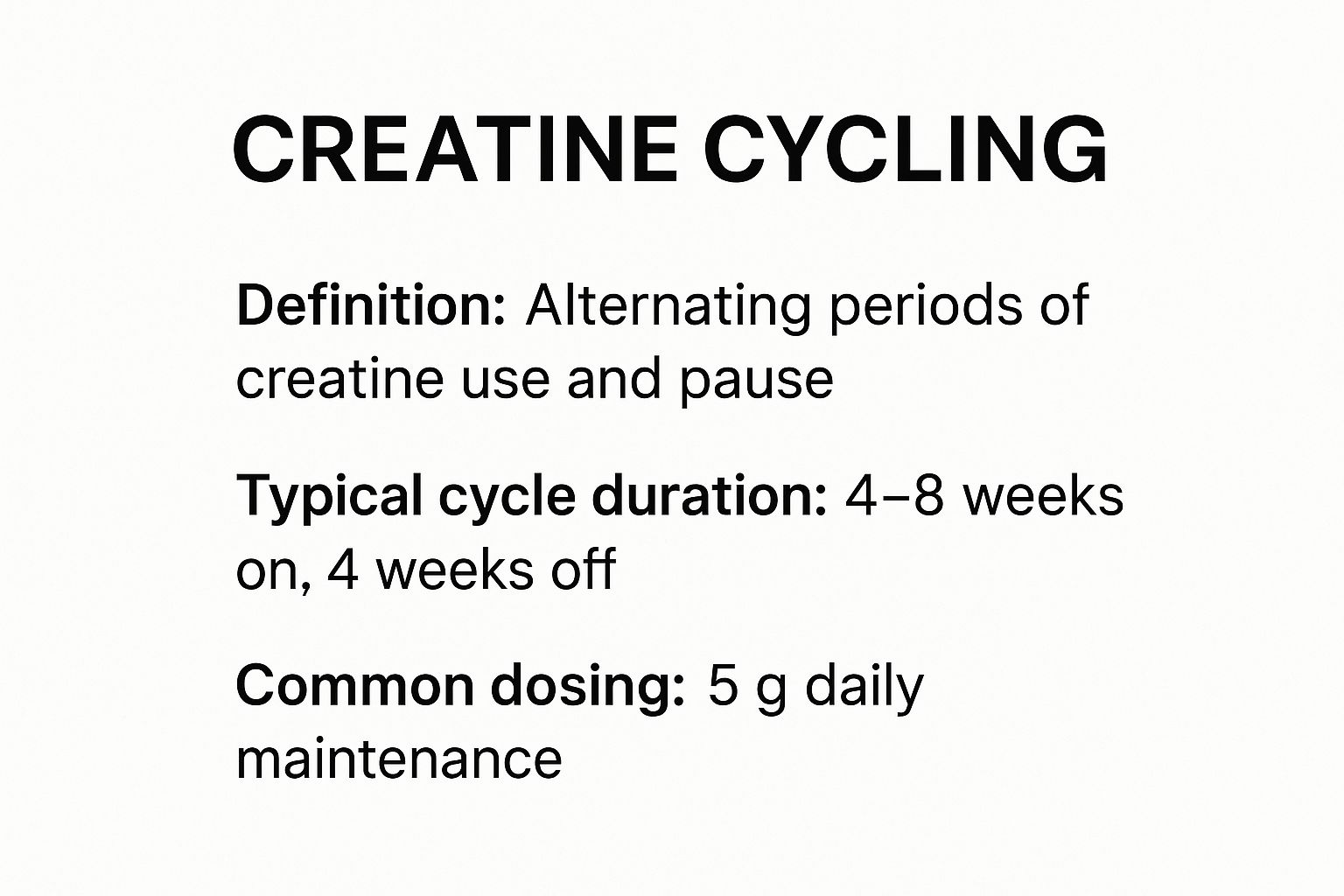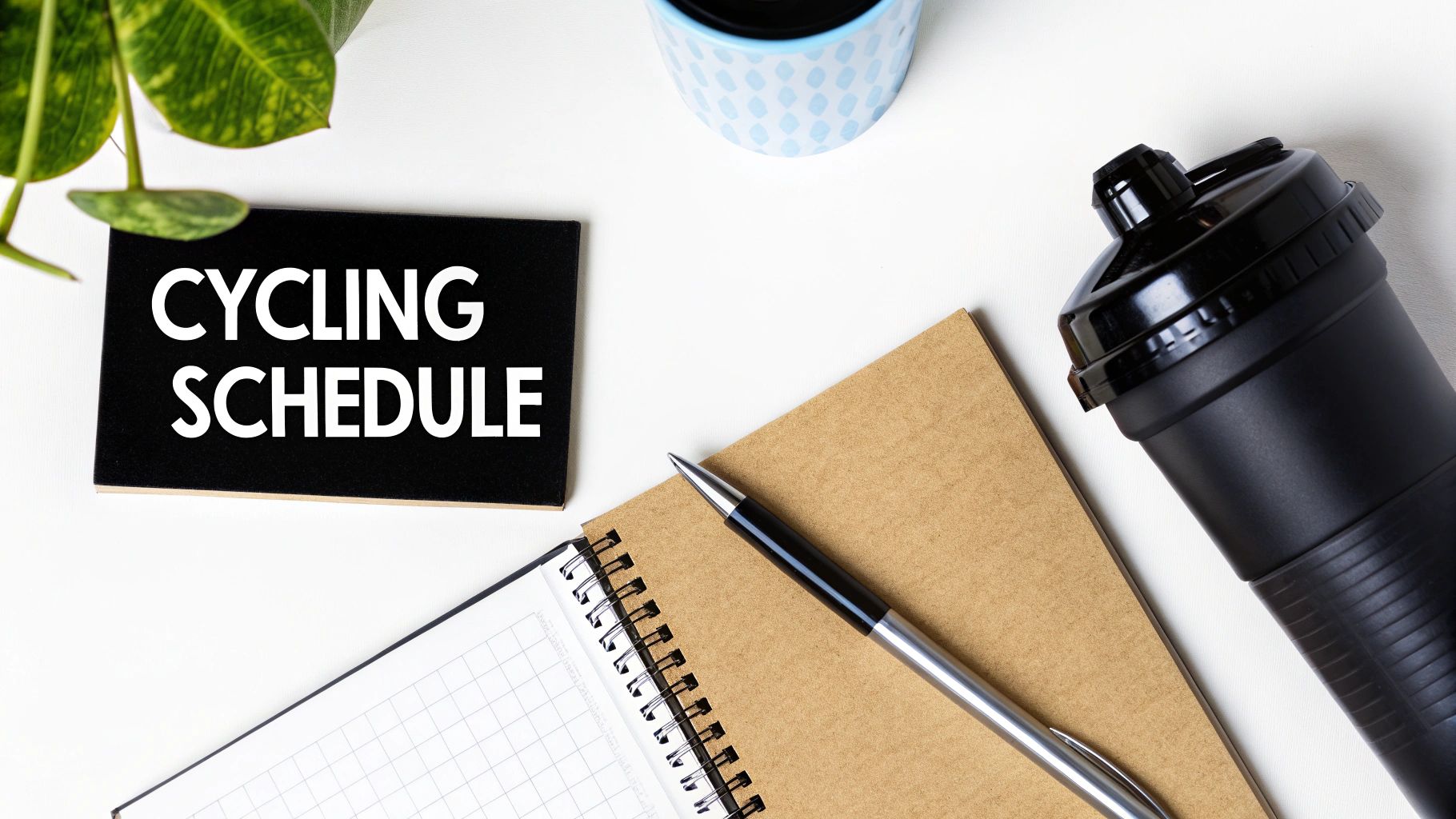
Should Creatine Be Cycled? Expert Tips for Best Results
Share
Let’s cut right to the chase: for the vast majority of people, the answer is a firm no—creatine does not need to be cycled. The idea of cycling is a holdover from the early days of sports supplements, but modern research has consistently shown that continuous daily use is perfectly safe and, frankly, more effective for keeping your performance levels high and your muscle gains steady.
Why Consistent Creatine Use Wins
Think of your muscle cells as a sponge and creatine as water. The whole point of taking a creatine supplement is to get that sponge fully saturated and keep it that way. When your muscles are maxed out with creatine, they’re primed for peak power, strength, and endurance during your workouts.
Taking a small, daily maintenance dose is like giving that sponge just enough water each day to keep it from drying out. You're simply topping off the creatine your body uses up, ensuring your muscles are always ready to perform.
So, what happens when you cycle off? You’re essentially letting that sponge dry out. Your muscle creatine levels drop, and with them, some of the performance benefits you worked to gain. When you start your "on" cycle again, you have to spend the first few weeks just re-saturating the sponge to get back to where you were. This on-again, off-again approach just creates needless dips in performance and interrupts the very process that drives results.
Different Paths to Supplementation
To really understand why sticking with a steady dose makes the most sense, it helps to see how it stacks up against other common strategies. The image below outlines what a typical creatine cycle looks like.
This visual gives you a quick breakdown of the loading, maintenance, and "off" phases that define a traditional cycling protocol.

As you can see, the key feature of cycling is that mandatory "off" period. And that’s precisely what decades of research now tell us is unnecessary for getting the full, long-term benefits of creatine.
To make things even clearer, here’s a quick summary comparing the three main approaches to creatine supplementation, helping you visually grasp the differences and choose your path.
Creatine Supplementation Strategies at a Glance
| Strategy | What It Involves | Primary Goal |
|---|---|---|
| Loading | A high dose (20g/day) for 5–7 days, then dropping to a lower maintenance dose. | Saturate muscles as quickly as possible—usually within a week. |
| Maintenance | A consistent, smaller dose (3–5g/day) taken from day one. | Gradually saturate muscles and maintain those optimal levels over the long haul. |
| Cycling | Alternating between periods of taking creatine (e.g., 8 weeks on) and taking none (e.g., 4 weeks off). | An outdated method based on the unsupported theory of preventing "tolerance." |
Ultimately, whether you choose to do a quick loading phase or just start with a steady maintenance dose, the goal is the same: get your muscle creatine levels up and keep them there. Cycling simply works against that goal.
Where the Idea of Creatine Cycling Came From

If all the modern science says continuous creatine use is safe and effective, you're probably wondering why we're even talking about cycling it. The idea is basically a relic, a holdover from the early days of sports nutrition when we knew a lot less than we do now. It was born out of caution, not conclusive evidence.
Back when creatine first hit the scene, long-term studies just didn't exist. So, athletes and researchers did the logical thing: they borrowed a principle from other powerful compounds like anabolic steroids, which absolutely must be cycled to avoid serious health issues. The thinking was pretty straightforward—if something changes how your body works, it's probably a good idea to take a break from it now and then.
The Old-School Theory of Downregulation
The biggest fear was a concept called downregulation. The theory goes that if you constantly feed your body something from an outside source, it might get lazy and stop making its own or become less sensitive to it.
Think of it like this: your body has "creatine transporters," which are like little microscopic workers that carry creatine from your blood into your muscles. The old hypothesis was that if you bombard these workers with a non-stop supply of creatine, they might just slack off or disappear altogether.
On top of that, there was a worry that the body's internal creatine factories—located mostly in the liver and kidneys—would just shut down production if they sensed there was already plenty to go around. The whole "on-off" cycle was proposed as a way to let these natural systems "reset" themselves. This is where protocols like the classic 8 weeks on, 4 weeks off cycle came from.
The creatine cycling protocol was born from a 'better-safe-than-sorry' mindset. It was a logical precaution based on how other performance enhancers worked, proposed at a time when the long-term safety and physiological impact of creatine were not yet fully understood.
Moving From Hypothesis to Evidence
This early caution was completely understandable at the time. But in the decades since, study after study has put these ideas to the test, and they just don't hold up. Research has shown that even after long-term use, the body's natural creatine production bounces right back to normal levels shortly after you stop taking it.
And what about those transporter "workers"? It turns out the feared downregulation doesn't seem to have any real impact on performance where it counts—in the gym or on the field.
Modern science has replaced those early guesses with a mountain of evidence. We now know that taking creatine consistently is not only safe but is also the best way to keep your muscles saturated and reap the benefits day in and day out. The myth of cycling hangs on today mostly as gym folklore, a piece of outdated advice that got passed down long after the science had moved on.
The Science Behind Continuous Creatine Use
If you've been around the gym for a while, you've probably heard the old advice about cycling creatine. But modern research has pretty much turned that idea on its head, pointing instead to the benefits of simple, consistent, daily use. The science is solid on this: continuous supplementation is safe, effective, and frankly, the easiest way to keep enjoying the performance boost creatine provides. The whole approach is built around a key physiological concept: muscle saturation.

Here's a simple way to think about it. Imagine your muscles are like a bucket you want to fill with creatine. The whole point of taking a supplement is to fill that bucket to the very top—what scientists call the saturation point. Once it's full, you've got a powerful reserve of energy ready to go for those intense, explosive movements like heavy lifts or sprints.
The Leaky Bucket Analogy
Now, to really get why continuous use makes sense, let's stick with that bucket analogy. Imagine your creatine-filled bucket has a tiny, slow leak at the bottom. It's not a huge gush, just a small, steady trickle. Every day, your body naturally uses and breaks down a little bit of its creatine—about 1-2% of your total stores. That's the leak.
Your muscles are the bucket, and a small daily dose of 3-5 grams is all you need to replace the little bit that naturally drains out each day. This keeps you topped up and ready for your next workout without any performance dips.
Taking a daily maintenance dose is like placing that leaky bucket under a faucet that’s dripping at the exact same rate. It constantly replaces the small amount you lose, keeping the bucket full all the time. Your muscles stay saturated and primed for peak performance. Cycling, on the other hand, is like letting the bucket drain halfway before you decide to fill it back up again. It's just not as efficient.
Why Your Body Doesn't Build a Tolerance
One of the big worries that led to the idea of cycling was tolerance. People feared that their bodies would get lazy, either by stopping their own natural creatine production or by becoming less responsive to the supplement. But after decades of research, these concerns just haven't held up. Study after study shows that long-term, continuous use is perfectly safe and effective, with no drop-off in results.
Even in studies that run for months on end, participants keep reaping the benefits without needing a break. For example, a landmark 32-week study on older adults in a resistance training program showed that the group taking creatine continuously had significantly better strength gains than the placebo group. There were zero signs of performance plateauing or negative side effects, which really drives home that consistent dosing works. You can dive into the specifics of this extensive creatine study to learn more about its outcomes.
The bulk of scientific evidence today tells a very different story from the old gym lore. Here’s what we now know for sure:
- Natural Production Bounces Back: If you do stop taking creatine, your body's natural production kicks right back into gear and returns to its normal baseline.
- Transporters Keep Working: The creatine transporters—the cellular "gatekeepers" that pull creatine into your muscles—don't get lazy or down-regulate. They keep doing their job just fine, even with long-term supplementation.
- Performance Stays High: Keeping those muscle stores topped off is what delivers the benefits. Consistent dosing is the most direct way to maintain that saturation.
In the end, the science points to a refreshingly simple strategy. A small daily dose keeps your muscle creatine stores full, ensuring you get the most out of every single training session. No complex schedules, no guesswork—just consistent results.
How the Creatine Loading Phase Works

While sticking to a consistent daily dose is the bedrock of smart creatine use, you’ve probably come across a popular strategy to jumpstart the process: the loading phase. This often gets mentioned in the same breath as cycling, but they serve totally different purposes. Loading is really just a shortcut—a way to get to the destination faster, but not the only way to get there.
Think of it as express shipping for your muscles. The whole point is to saturate them with creatine as fast as possible, unlocking its performance benefits in about a week instead of the usual month. It's totally optional, but it's a go-to method for people who are eager to feel the effects sooner rather than later.
The Standard Loading Protocol
The most common loading protocol is pretty simple, but it does take a bit more planning than just scooping a single daily dose. It’s all about a short burst of high-dose supplementation to get your muscles topped off quickly.
Here’s the typical game plan:
- Dosage: Take about 20 grams of creatine each day.
- Duration: Keep this up for 5 to 7 days.
- Frequency: Break that daily total into four 5-gram servings spread throughout the day.
Splitting the dose is key here. Trying to down 20 grams all at once is a good way to upset your stomach. Spacing it out helps your body absorb it better and keeps digestive issues at bay. A lot of people find it helps to take each dose with a meal or a snack with some carbs to boost absorption and make it easier on the gut.
The loading phase is a strategic choice, not a mandatory step. It's designed to accelerate muscle saturation, delivering creatine’s performance benefits in about one week instead of the typical three to four weeks required by a standard maintenance dose alone.
Once that initial week is over, you just dial it back to the standard 3-5 gram maintenance dose. This keeps those freshly filled creatine stores topped off. This high-dose, short-term approach isn't just gym lore; it's backed by decades of research. Studies have shown that taking 20 grams daily for just five days can crank up your muscle creatine levels by about 20%. That gets you to near-maximal saturation much, much faster than a lower daily dose.
In the end, whether you load or not, you'll get to the same place: fully saturated muscles. The only real difference is how quickly you arrive. If you’re kicking off a new training cycle or prepping for an event and want every advantage right away, loading is a solid choice. But if you prefer to keep things simple and aren't in a rush, just starting with 3-5 grams a day will get the job done perfectly fine. Check out our detailed guide on the creatine monohydrate loading phase to figure out which approach fits you best.
When You Might Consider Cycling Creatine
So, is there ever a good reason to take a break from creatine? While the science overwhelmingly points to continuous, daily use as the best approach, a few very specific situations might lead someone to temporarily stop.
It’s important to see these as exceptions, not the rule. For the average person hitting the gym to build strength and muscle—we're talking over 99% of users—staying on creatine consistently is the way to go. But let's look at the rare cases where a pause could make sense.
Specific Scenarios for Cycling
A classic example comes from the world of competitive bodybuilding, specifically in the final days leading up to a competition. Creatine helps muscles retain water, which is fantastic for that full, powerful look most of the time. But right before stepping on stage, some competitors want an ultra "dry" and shredded appearance, so they might cut out creatine to drop that last bit of intracellular water.
Another scenario involves athletes who are under the strict guidance of a coach or sports nutritionist. Occasionally, a training camp protocol or a highly structured diet plan will include breaks from all supplements. In this case, an athlete would simply be following the expert advice they've been given for a specific phase of their training.
At its core, the decision to cycle creatine in modern fitness is less about scientific necessity and more about personal preference or highly specific, short-term goals. For everyday performance, continuous use remains superior.
Finally, some people just like to cycle everything. It's a personal philosophy—they feel more comfortable taking periodic breaks from any supplement they put in their body. Even though the research shows it's not necessary for creatine, it's a personal choice rather than a decision driven by any real physiological need.
Ultimately, knowing why someone might choose to cycle helps you make a better decision for yourself. If you're curious about what a structured on-off protocol looks like, our guide on how to cycle creatine breaks it all down. For nearly everyone else, though, the answer to "should I cycle creatine?" is a firm and confident "no."
Your Simple Guide to Taking Creatine Effectively
Alright, we've waded through the science. Now, let's talk about what actually matters: how to put this stuff into practice. The good news is that taking creatine effectively is incredibly straightforward, despite all the complicated advice you might see online.
Think of it like starting a road trip. You can either hit the express lane to get to your destination as fast as possible, or you can take the slower, scenic route. Both get you to the same place: muscles fully loaded with creatine and ready to perform.
The Two Paths to Creatine Saturation
You’ve got two main options here, and honestly, both work great. Your choice just depends on whether you value speed or simplicity more.
-
The Fast Track (Loading Phase): This is for anyone who wants to feel the benefits ASAP. You’ll take 20 grams of creatine per day for the first 5-7 days. Most people split this into four 5-gram servings to make it easier on the stomach. After that week, you drop down to a smaller maintenance dose.
-
The Steady Path (Maintenance Only): This is the set-it-and-forget-it method. You just skip the loading phase entirely and start with a daily maintenance dose of 3-5 grams. It's simpler, but it will take about three to four weeks for your muscles to become fully saturated.
No matter which path you start with, the daily maintenance dose is what matters for the long haul. A consistent 3-5 grams is all you need to keep your creatine stores topped off. For a deeper dive, check out our complete creatine dosage guide for more personalized advice.
Key Tips for Success
To really get the most out of your creatine, a few simple habits can make a surprising difference.
First off, don't stress about timing. Just take your creatine whenever it's most convenient for you to be consistent. That said, some people find that taking it post-workout with a meal that has carbs and protein seems to help with absorption.
Next, drink your water. Creatine works by pulling water into your muscle cells, which is a key part of how it boosts performance. Staying well-hydrated supports this process and just helps you feel better all around.
Some of the old-school advice was to take breaks from creatine, but modern research shows that keeping your levels consistently high is what drives performance. For steady gains, continuous use is the way to go.
Finally, just stick with creatine monohydrate. It’s the form that’s been studied the most, proven to be the most effective, and it’s also the cheapest. Huge studies confirm that keeping creatine levels high is what boosts power, and there's no solid evidence that cycling on and off does anything to improve those results. If you want to nerd out, you can discover more about these creatine findings and see why consistency really is king.
Got Questions About Creatine? Let's Clear Things Up.
Even with the best plan, you're bound to have some questions. It’s only natural. Let's tackle some of the most common ones I hear from athletes and gym-goers so you can move forward with total confidence.
Will I Lose My Gains if I Stop Taking Creatine?
This is a huge fear for a lot of people, but you can relax. You won't lose the actual muscle you’ve built in the gym. That hard work isn't going anywhere.
What will happen is your creatine stores will slowly drop back to their normal, pre-supplement levels over a few weeks. When this happens, you might feel a small dip in your top-end strength or that last bit of explosive power. You may also notice your muscles look a little less “full,” but that's just water leaving the muscle cell—not the muscle tissue itself.
Think of it this way: the muscle fibers you built are permanent. The changes you'll see are mostly related to that intracellular water and maybe a slight decrease in peak performance as your body's creatine levels normalize.
Is It Safe to Take Creatine Every Day, Long-Term?
Yes, absolutely. For healthy people, the mountain of scientific evidence points to creatine monohydrate being incredibly safe for long-term daily use.
We’re talking about numerous studies, some lasting for years, that have shown no negative impact on kidney or liver health in healthy folks sticking to the standard 3-5 gram daily dose. It’s genuinely one of the most studied and validated supplements on the market.
Does Creatine Cause Dehydration or Cramping?
This is one of those old-school gym myths that just won't die, but it’s been thoroughly debunked. In reality, creatine does the exact opposite—it pulls water into your muscle cells, which actually boosts your cellular hydration.
This improved hydration can help your body better manage its temperature during tough workouts and might even lower your risk of cramps and injuries. Of course, you should always be drinking plenty of water as part of any good training regimen, but creatine isn't the culprit here.
Tired of dealing with messy powders and shaker bottles? Smash.com makes it simple with premium creatine gummies that pack your full 5-gram dose into a few tasty bites. Fuel your gains the easy way with Smash.com.